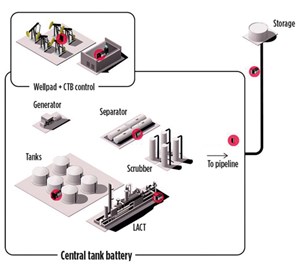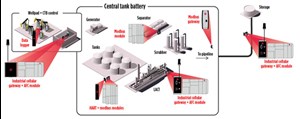Single measurement and control solution simplifies multi-well pad operations
Technological advancements have enabled operators to effectively develop U.S. shale fields, helping companies create new production opportunities and increase operational efficiencies, while reducing costs. These innovations, combined with new digital and IIoT solutions, have changed the typical field configuration from single-well pads to more complex, multi-well pads, Fig. 1.
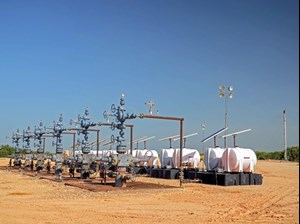
Producers are now placing anywhere from 10, to more than 30 wells on a single pad. While multi-well pads have a variety of benefits, the increase in size and scope has created a new challenge—much greater data and control requirements. These new conditions are increasing pressure on producers to maintain data integrity and accuracy.
HISTORICAL LIMITATIONS
The new multi-pad locations are pushing traditional control architectures, such as remote terminal unit (RTU) technology, to their limits, due to maintenance costs, scalability and data/measurement capabilities. It has become increasingly difficult for RTUs to keep up with these demands.
Each well in a multi-well pad requires artificial lift, equipment control, flow and level measurement—creating more control and data acquisition demands than a traditional, single RTU can handle. As a result, producers need to purchase additional RTUs to spread control across multiple units, Fig. 2. However, there are challenges that come with this approach:
- Multiple RTUs can create control infrastructure entanglements—requiring maintenance of multiple application configurations and programs, complicating communication management.
- Multiple vendors’ hardware (for control, measurement, sensors, LACT units) can limit SCADA communication, complicate integration and make training practices more difficult for maintenance and operations, increasing overhead, Fig. 3.
- “Black-box” RTUs, designed with specific inputs and outputs, can limit flexibility for changing or upgrading systems, and create service and support challenges.
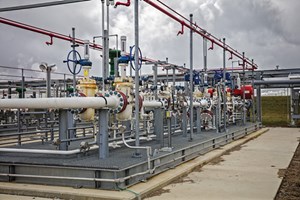
Operators and managers, who have experienced common RTU issues, can find better solutions in modular and scalable, single-control platforms, such as programmable logic controller (PLC) technology. In this architecture, everything can be linked together, so producers have a single system for all oil and gas measurement and control.
SINGLE PLATFORM BENEFITS
Modular. With multi-discipline control, PLCs can be configured in different ways, enabling control of a wide variety of field instruments. Operators can achieve normal automation of well pads, as well as combined process and discrete control, with one system that also supports communication for many different network types.
Scalable.PLCs offer predefined libraries and code that can be added instantly and configured on-site. This makes it easier to add new hardware—with no new code required—so, as well pads grow with production increases, it is easy to scale control to accommodate new wells and integrate into control on the pre-existing pad. This minimizes the need for technicians to write new codes, when hardware is added, which helps to eliminate downtime and decrease spending.
Furthermore, with traditional RTU technology, measurement isn’t easily integrated, or scalable—multiple networks need to be pieced together in a field, or well pad. Today, advanced modules, such as an in-chassis oil and gas flow computer, achieve required measurement standards within the control architecture. This allows producers to have one architecture for control and measurement without requiring any licensing fees, and eliminating the challenging effort to integrate multiple vendor products. This also helps simplify deployment and enables measurement scalability for any future wellsite or system expansions.
Data control and integrity.Due to the limited control capabilities of RTU systems and the need to integrate various systems together from various solution providers, data integrity is in jeopardy. Any time data move from one system to another, integrity is at risk. With integrated infrastructure solutions like the ProSoft Technology flow computer module and Rockwell Automation control platform, producers can help guarantee the integrity of their data because:
- Control data and flow data from the module can be kept in their native format, and they don’t need to be aggregated.
- The solution is capable of a more granular level of data – providing information down to the millisecond, to support industry measurement standards and help ensure data accuracy at custody transfer.
- The solution also can support larger-scale measurement from larger meter runs than traditional solutions.
- The flow computer from ProSoft technology operates as a co-processor to the Rockwell Automation control platform, offloading measurement functions from the main central processing unit, while maintaining secure data.
- Embedded remote I/O functionality allows for control of the complete operation and insight to measurement/data from a mobile device and allows producers to wire field devicescloser to where they sit, minimizing field installation, wiring and commissioning time.
NEW PLATFORM SOLUTION
ARC Resources, a conventional oil and gas company, implemented a system with the goal of minimizing footprint and streamlining operations across their multi-well pad site in western Canada.
The existing controllers were not capable of handling the large amount of I/O required to run the entire well pad. As a result, the company had to use multiple controllers, which were hardwired together, along with remote terminal units. This limited the amount of information available for control and monitoring. Additionally, the producer used stand-alone flow computers to meter natural gas—they could only handle 8 m runs apiece, which was not optimal for a large operation with planned future expansion.
To optimize control and measurement, ARC Resources implemented the well manager solution from Rockwell Automation, based on the ControlLogix PLC control platform, and the ProSoft Technology Flow Computer for better data integration, Fig. 4.
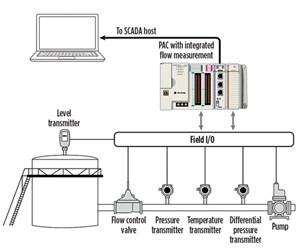
This solution eliminated the need for multiple controllers and RTUs, simplifying the overall wellsite architecture, and lowering hardware and software costs. It also increased data visibility for better control and maintenance. The use of the integrated flow computer reduced wiring requirements, enabling full support of large meter runs and enhanced data integrity and measurement. ARC Resources also was able to reduce capital expenditure, as the new solution required no licensing fees, whereas each previously installed RTU had an associated fee. The new, modern solution also reduced the cabinet size, and overall hardware and control footprint.
SYSTEM BENEFITS
Multi-well pads have increased data and application requirements significantly in upstream operations. With data coming in from multiple locations, it is important to have the ability to properly manage the information in one system, Fig. 5. Modular and scalable PLCs are capable of delivering scalable architectures required by modern well pads and easily integrate with other systems, such as flow modules. Moving to a single solution allows for enhanced data integrity, improved scalability, and reduced installation times and costs. WO
- Shale technology: Bayesian variable pressure decline-curve analysis for shale gas wells (March 2024)
- U.S. oil and natural gas production hits record highs (February 2024)
- When electric meets intelligence: Powering a new era in hydraulic fracturing (January 2024)
- Next-generation electric fracturing system improves efficiency, ESG performance (January 2024)
- Going global with unconventionals (December 2023)
- Singlet oxygen-generating treatment technology achieves sustainable operations, helps operators meet production goals (November 2023)

